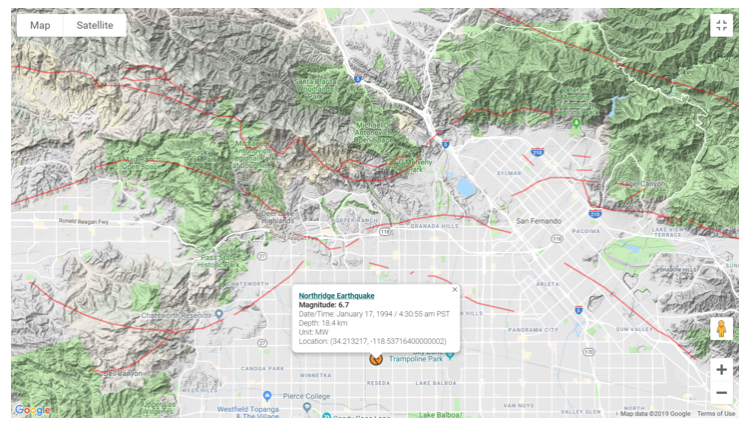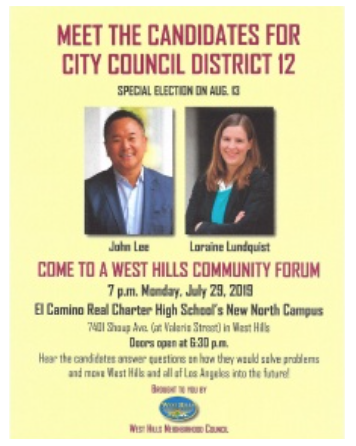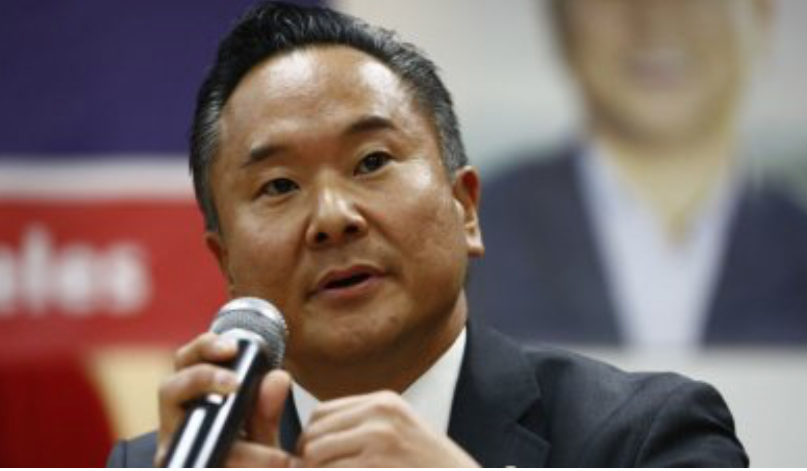CommentsFIRST PERSON-On July 10, 2019, I interviewed John Lee, one of the two remaining candidates for Council District 12’s special election to replace Councilmember Mitch Englander. The election will take place on August 13, 2019.
This race is important to me because I have lived in West Hills (part of CD12) for 41 years and in the past, have served on my Neighborhood Council. I have also requested a meeting with the other CD 12 candidate, Loraine Lundquist.
I was pleased to have the opportunity to speak with John Lee. While this interview is not an endorsement of his candidacy, I was made to feel that my voice would be heard if he were to be elected. If you live in CD 12, it’s up to you to evaluate the information presented here and decide who you will vote for in the upcoming election.
I requested that John Lee’s campaign manager not be present during the interview so that only the candidate would be responding to my questions. However, a campaign staff member, who remained silent, was present to facilitate the meeting.
Question 1: What is the most important issue for you as the candidate?
John Lee: Homelessness is at a level that not only has the City never experienced, but especially Council District 12. It’s always been a problem downtown, but it never hit our community as hard as it has been. And I believe that we need to start addressing some of these issues--we have diseases that are coming back that have been eradicated for many years. I don’t know when the last case of typhus was reported, and this is worrisome. I don’t believe that the way that we are now facing this crisis is humane.
Question 2: Do you have any suggestions?
John Lee: I think that it is a combination. The message downtown is talking about--all I hear about is housing, “We need more housing, we need more housing…,” and while I believe that is true, that we do need more housing, I also believe that there is a drug problem involved with this, there is a mental illness part to this, and I believe, I have always believed, that we need to be compassionate to all of the different parties. That is why, as a Board member of the San Fernando Valley Rescue Mission for the families that are truly affected by being one pay check away, we provided a place where families, [once] they leave the program, are currently at a 93% success rate; only 7% over the last four years of the families that have visited and been guests at the Rescue Mission have found themselves back on the streets. And I think it is important to note that we’ve done this at absolutely no expense to the taxpayers.
This is 100% privately funded, because honestly, as an organization, they feel that the moment you take a penny of government money, you have to run things by their standards, and we think that it is too focused on [being] funding-based, [rather than] people-based, and it’s too focused on the amount of people being helped rather than results.
I am very proud to be a part of that, but I am also proud that, [during] my time in City Hall, especially as Chief of Staff of CD 12, I also thought it was important to be compassionate toward homeowners. That is why we started finding funding for our “Neighborhood’s First” program so that we could have a dedicated group of officers from the “Hope Team,” Sanitation, and Department of Transportation, can go out three or four times a week to address the needs, to break those barriers down.
Sometimes when you are working with people on the streets, a level of trust needs to be gained before they accept those services. I believe we have done a very successful job whereas other Council districts have, I believe, only had this service maybe two or three times a month. We have a dedicated team that is specifically dedicated to CD 12. That is something I believe we have [achieved] a good balance of.
Question 3: Are there any properties in CD 12 that you have identified for the “Housing First” program? Have you examined the property identified near the Orange Line that was suggested by one of the candidates? Is that something that the neighbors would object to?
John Lee: I think that no matter where we end up putting these facilities of any type, whether they are for families or if they are for any level of homelessness, [whether with addiction issues], there is going to be some resistance from the communities around it. When we put the Rescue Mission at its current location, I would be lying to you if I said that the community around it was not exactly excited about the placement of it.
Question 4: Where is it located?
John Lee: It is located in Northridge on Canby Street between Nordhoff and Parthenia, one block east of Reseda. But we listened to the community; we didn’t just jam it down their throats; [they] were a part of the process. That is what I have been doing my whole life . . . consensus building. We listened to them, we listened to their concerns. I have not been in City Hall for a few years now, but I don’t believe in the four years that they have been operating, that the Council office has received one complaint from the community. I think that the community thinks that location and that program is [the jewel of Northridge]. If you saw this place, you could drive by it without even knowing that it was there. And it’s a beautiful place where we [show] dignity to families; they are our guests while staying there, and it’s a program obviously that some families need [for] 60 days; some families need seven months, but when they go through the program, we’ve had great success.
I plan on working with the community; [there is a site that] has been proposed to be near the Orange Line which obviously would make sense . . . but in the past as I understand it, [in] CD 12, we’re not developers. [There had been] two other proposed sites . . . but the developers backed out of the deal. No fault to the Council district. So we need to find areas that work, but we need to make sure that when we are placing these places, there are . . . homeless people [who are] “one pay check away”; and I think that our communities would understand [that they are] helping seniors, people with children, but I’m hesitant to ever place one of these places where [it poses] . . . any type of danger to the local residents.
Question 5: In the debates, you had diverse perspectives. One candidate was talking about the police involvement with the homelessness issue, and another talked about how it should be a social worker approaching them. My understanding is that LAHSA is who goes in, as you mentioned, “housing first.” Should social workers be going in first, or should it be LAHSA? Should police be going in with them or are LAHSA and social workers safe going into these locations where, as you mentioned earlier, some people are drug addicted or may have mental disorders?
John Lee: I believe that so much burden is placed on our public safety officers these days, but several Councilmembers have made the claim that law enforcement being a part of the process is actually putting fear into some of the people [who need] help. I don’t know if I necessarily agree with that. I believe the police are there to ensure the safety of the people reaching out to them; there are instances where they are posed with a situation. The process, whether they are just on standby, located nearby, and called in only if it is necessary to . . . address the concerns of the Councilmembers. I do believe that, if they are asked to be there, then I am sure that they will agree that they need to be there.
Question 6: Do you know how many homeless there are in CD 12?
John Lee: I believe at the last count there was something [around 700].
Question 7: We recently have felt some earthquakes. Where were you during the Northridge earthquake?
John Lee: That was my Senior year at Northridge (CSUN). I had a unique experience. I was back living at home, and it was an interesting thing because we had to adjust our classes--some were on the lawns and different areas of the school . . . [which] did its best to try to accommodate--to make sure that, especially with us Seniors, that the school tried to provide the ability to get the . . . [classes needed to graduate].
Question 8: I brought photos of the fault lines (in the San Fernando Valley with an emphasis on CD 12). We originally believed that the epicenter of the Northridge quake was in the mountain range to the north; thus, it was called the Northridge quake. But now we have learned that the epicenter of the quake was in Reseda. (see map below) As I looked at the Porter Ranch area on the way to this meeting, and I thought about these faults, do you have any concerns that make you think twice about future development in these hills?

John Lee: I know that there is a part of the Master Plan, agreed upon many, many years ago, maybe forty years ago, [in] the Porter Ranch area; I believe that as its mapped out, they still have hundreds of homes still left there as part of that agreement to build. I [couldn’t change that] if I wanted to. They have that agreement and--
Question 9: --they have entitlements?
John Lee: Correct.
Question 10: Aliso Canyon–because of these faults, do you think it should be shut down?
John Lee: I do. You know what? I have a unique perspective again on this issue. I live in Porter Ranch. My family, my wife, my two kids, and my dog were all relocated. I spent Christmas in a hotel. At the same time, I volunteered to serve on the Citizen Advisory Committee. I helped to extend the radius of the service relocation past Porter Ranch to a five-mile radius of the Aliso Canyon site. I fought for the relocation–the process of relocating thousands of homes; I fought for [homes’ receipts], air filtration systems, scrubbing of the outsides of the homes, relocating two schools. . . .This was a 24-hour job because while I was working as the Chief of Staff, dealing with this during the day, and at night, I was in a hotel filled with Porter Ranch residents. My job did not stop [at night].
Working with the community, and as a part of the Citizens’ Advisory Committee, we did our best to ensure the safety of the residents of CD 12. Now if you look at the results of this past election, in no community did I have the strongest support, [further] than my other opponents, than [in] Porter Ranch. And I believe that is a direct result of my involvement when the Aliso Canyon Blow Out happened. I think that they believe . . . my concern is as a resident who lives in the area, and as a resident, [I] understood issues and shared their same concerns.
I have lived here since 1978. I think we all knew there was a gas field there. I don’t think that any of us understood the extent or the size of it. And so, this is something that, absolutely, I think it needs to be shut down. The past Governor has put a ten-year mandate on closing it down. The problem is that there is no ten-year plan. And what is going to happen is that, it’s already been two years, and seven years down the line [are we] going to find ourselves staring at each other, going, “How is this going to shut down?”
There is going to have to be a lot of different things that are going to have to take place – this gas field provides natural gas to millions of homes, and millions of people. And it is something we need to start right away. I think, as soon as I get elected, one of the first things I need to do is to fly up to Sacramento and meet with the PUC (Public Utilities Commission) and DOGGR (Division of Oil, Gas, and Geothermal Resources) to work directly with them on working on an actual plan to shut this facility down, and not just an empty mandate.
I want to work with all of the different parties involved; we need to understand just how this field [works] for our City, moving forward, we need to understand how we can shut it down safely so that it doesn’t affect lives. We need to understand how to provide energy to this area, and heat to senior citizens’ homes, when our hospitals need power; all of this needs to be taken into consideration when we start moving towards the eventual shut down of this area.
Question 11: Do you have a fear that the Ridgecrest shake may have displaced the pipes (in Aliso Canyon)?
John Lee: When we went to Aliso Canyon, I actually was the person that personally took the gentleman that installed the fenceline monitoring system around Aliso Canyon. I do believe that we would have been notified if there’s something–we’re a community that is very sensitive about this subject.
My next questions were related to the Santa Susana Field Laboratory. I asked if he had ever been there and he said he had not. I asked if he would be willing to go and he said, “Absolutely.” I asked if he knew where it was. “West of Chatsworth Reservoir,” he said. “This is a site that is long overdue to be cleaned up. I think that we have been ignored for our demands for [help] on the subject. It is my understanding that the Department of Energy and NASA both agreed to the cleanup, and I think we need to hold their feet to the fire to get it done immediately.”
I asked if he was aware that four Neighborhood Councils and some environmental groups have supported a risk-based cleanup of the Santa Susana Field Laboratory. He stated that he was not aware that four Neighborhood Councils had voted that way, but he was aware that West Hills had taken that position.
I asked if he would negotiate a risk-based cleanup, or if he would support the City’s position on litigation. Lee stated that he supports the City’s position on litigation regarding the cleanup of the Santa Susana Field Laboratory because “we have been ignored in this area, and it has gone on far too long–we need to address this issue.” He believes that the litigation process will get them back into the process to get them to do what they agreed to do.
I asked him what Committees he would like to serve on in Council. Lee stated that Public Safety has always been a major concern for him; and Public Works because he understands pavement issues and other related issues in Public Works more than many people in the City.
Because Lee mentioned his interest in Public Works, I brought up the issue of Hazardous Waste. I mentioned the Nicole Bernson SAFE Center and asked if he would support a second Hazardous Waste Facility (SAFE Center) in the West Valley near West Hills. “Absolutely,” he said. “I think that it is important to we dispose of all of those different types of materials (hazardous materials) in a safe environmentally, friendly way.”
 When I asked if he would consider looking into a mobile SAFE Center for Hazardous Waste, similar to “Large Item Pickup,” he said he would do that.
When I asked if he would consider looking into a mobile SAFE Center for Hazardous Waste, similar to “Large Item Pickup,” he said he would do that.
Upcoming candidate debates will include one held by the West Hills Neighborhood Council for this Council District Race:
The CD12 Candidate Forum
When: Jul 29, 2019 - 7:00 PM
Location: El Camino CHS Independent Study Campus
7401 Shoup Ave. (at Valerio), West Hills
Doors open 6:30 p.m.
Description: Candidate Forum; John Lee and Loraine Lundquist, candidates in the City Council District 12 special election, debate before the August 13 election.
Please be an educated voter, and vote in this Special Election for Council District 12 on August 13, 2019!
(Chris Rowe has been a 41-year resident of West Hills; she is a former West Hills Neighborhood Council Board Member where she was the Public Health Committee Chair; she has a B.S. in Health Education from CSUN). Edited for CityWatch by Linda Abrams.















